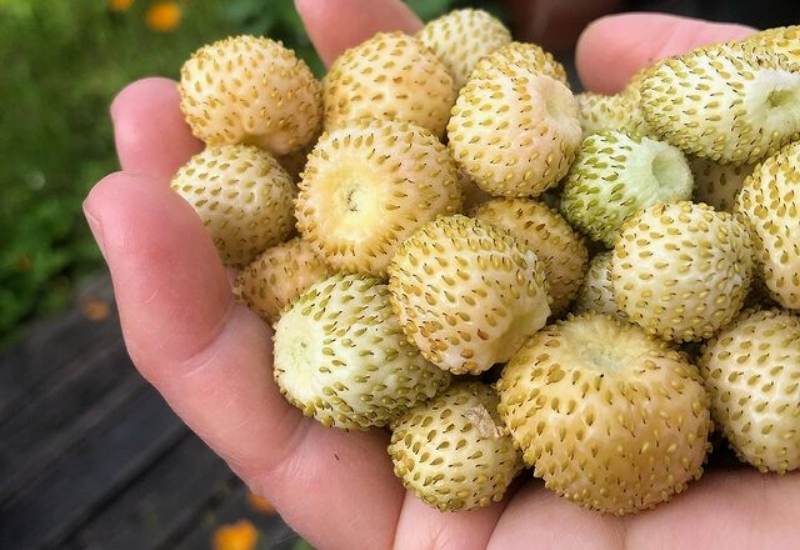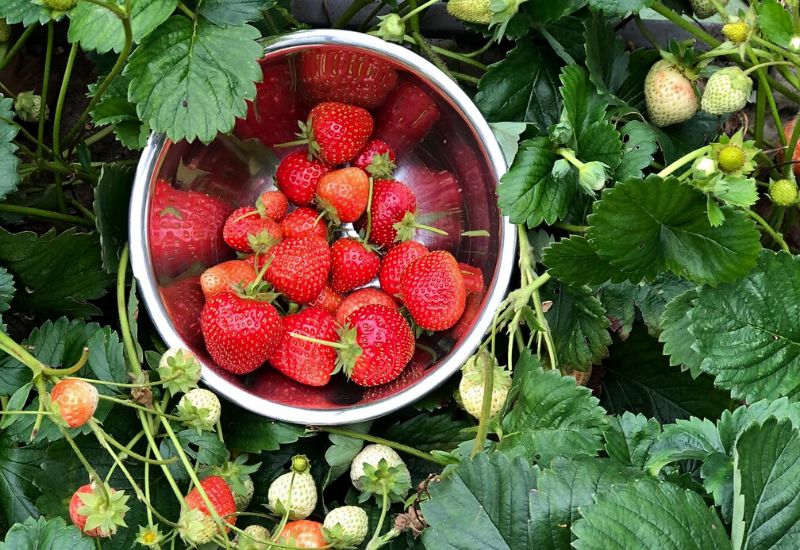
Do you love strawberries? Do you want to eat them fresh from your garden all summer long? If yes, then everbearing strawberries are the right choice for your garden.
Everbearing strawberries will produce berries throughout the growing season, and your berry patch will continually grow as the “walking” plants send out runners for new plants.
Everbearing strawberries can be harvested throughout spring, summer, and fall. You will be able to pick the berries as they continually ripen on the plants.
Let’s look at what everbearing strawberries are and how to grow them.
What Are Everbearing Strawberries?
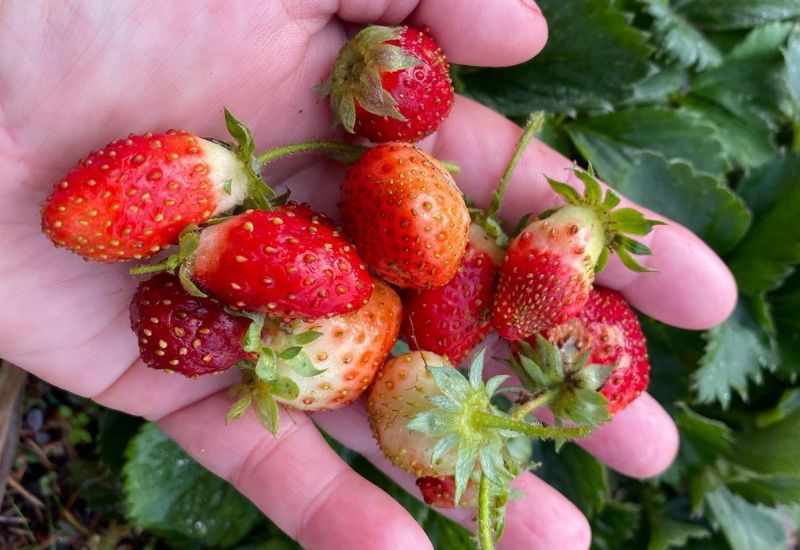
There is some disagreement about what a true “everbearing” strawberry really is. Everbearing is an old term that used to refer to strawberries that would produce two to three crops each year (in the spring, summer, and fall) often when there are 12 or more hours of sun during the day.
Modern cultivars are technically referred to as day-neutral strawberries, and they will continually flower and produce berries throughout the entire growing season. In most cases, day-neutral varieties are also referred to as everbearing.
Choosing A Variety Of Everbearing Strawberry
There are many varieties of everbearing strawberries to choose from. Here are a few popular varieties for the home garden or market garden production:
Fresca strawberries produce large red berries that work well in traditional beds as well as containers. They are a sprawling plant with a heavy yield.
Tarpan strawberries have medium-sized berries but instead of the traditional white flowers, it produces pink flowers reminiscent of a wild rose.
Albion have a good yield of large berries, and also send out lots of runners.
Yellow Wonder Alpine are a low-growing plant that produces yellow berries. They are ideal for starting from seeds as they are easier to start than many other varieties.
A Step-by-Step Guide To Growing Everbearing Strawberries
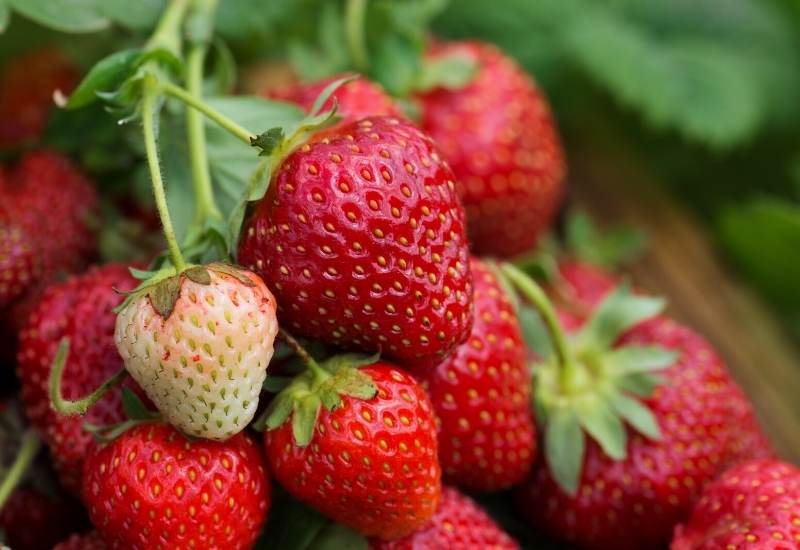
Many people say that everbearing strawberries are difficult to grow. In reality, they are an easily cultivated perennial. Given the right care, they will provide a delicious treat throughout the entire growing season.
When you first start growing everbearing strawberries, you can choose to start from seeds or buy already started plants or slips from a garden center. Growing from seeds is definitely the cheaper option and you will often have more varieties to choose from.
The most common, and easiest way is to start with already established crowns that you plant directly in your garden. We outline how to grow both ways below.
Here is a practical guide to growing everbearing strawberries for a bountiful harvest.
Choosing And Preparing A Site
Since strawberries are a perennial, your crop will be most successful in the long run if you carefully choose a site to grow them. In nature, wild strawberries are woodland plants and your cultivated varieties will thrive if you replicate their natural growing conditions.
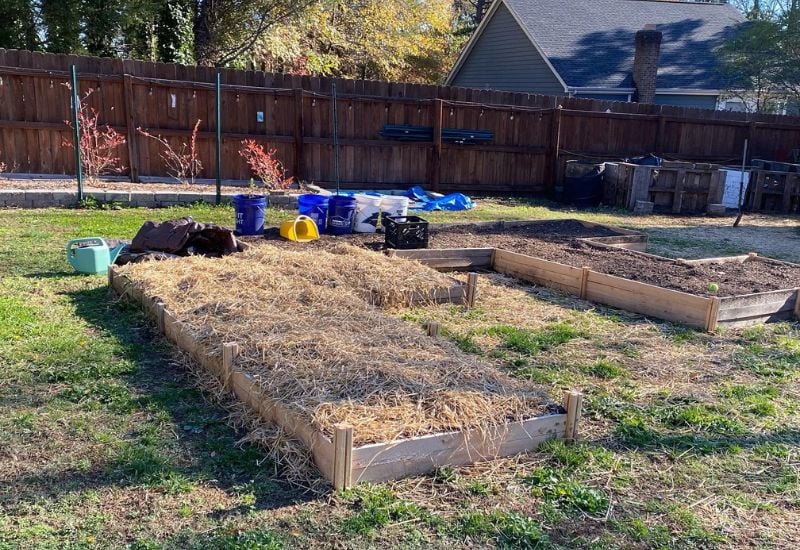
Sunlight. Select a spot that gets at least 6 hours of sunlight a day. Everbearing strawberries will tolerate shade but they produce better with more sunlight.
Soil pH. Everbearing Strawberries prefer slightly acidic soil ranging from a pH of 5.4 to 6.9.
Site Preparation. Like all strawberries, everbearing varieties grow best in loose, well-drained soil. Light soil with a fine tilth will provide a good medium for runners to take root, and it will help drain excess water and prevent rot.
Work plenty of compost or well-rotted manure into the bed prior to planting. Adding compost will not only feed your growing strawberries, but the additional humus will help loosen heavy soils.
Planting (Seeds)
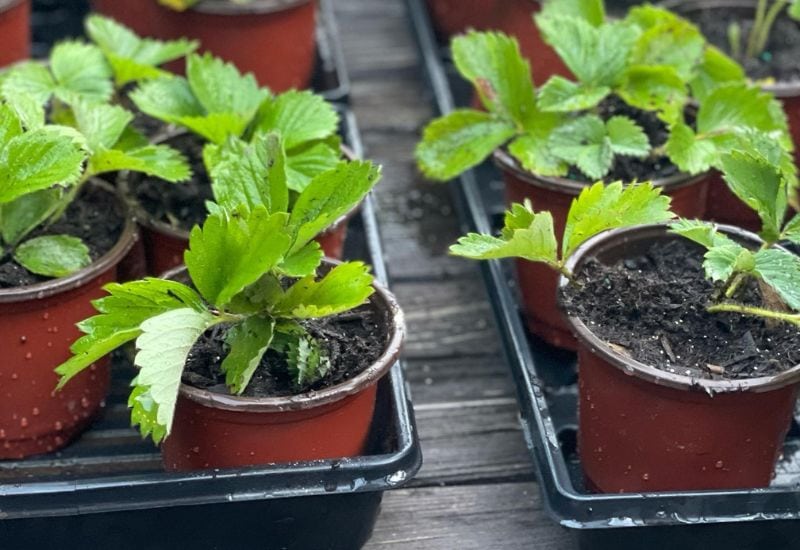
Start your everbearing strawberry seeds indoors in the winter. They can be started anytime from December to April.
The earlier you start your seeds improves your chances of having berries the first year, but you have to care for the plants for longer and have sufficient pot space to accommodate the growing plants.
You will greatly improve the germination success of your seeds by exposing them to cold temperatures before planting, in a process known as cold stratification. This replicates how the seeds lay waiting under the snow for spring to come.
To cold stratify your seeds, place the seeds packet in an air-tight container and put it in the freezer for about 1 month.
Some strawberry seeds do not require cold stratification, but it is better to go through with it if in doubt.
When you are ready to plant, take your seeds out of the freezer and allow them to warm up. Wait until the seeds have reached room temperature before opening them or the condensation moisture might reduce germination.
Sow the seeds into your preferred starting or potting mixture, and give them lots of supplemental light.
The ideal soil temperature is 18°C to 24°C (65°F to 75°F), and keep the soil moist. Under these conditions, germination will take anywhere between 1 to 6 weeks, though most seeds will emerge in 2 to 3 weeks.
Transplanting Into The Garden
Whether you start your seeds indoors or buy already established plants from the nursery, you want to plant your strawberry plants into the garden in the early spring.
The exact time to plant will be determined by your area, so check with your local garden center for the best time.
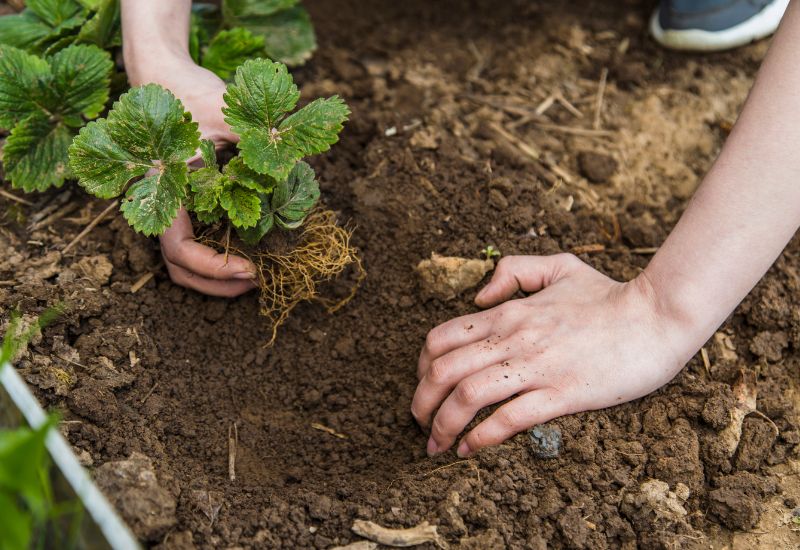
Make sure you harden off your young plants before transplanting them.
Propagating Runners
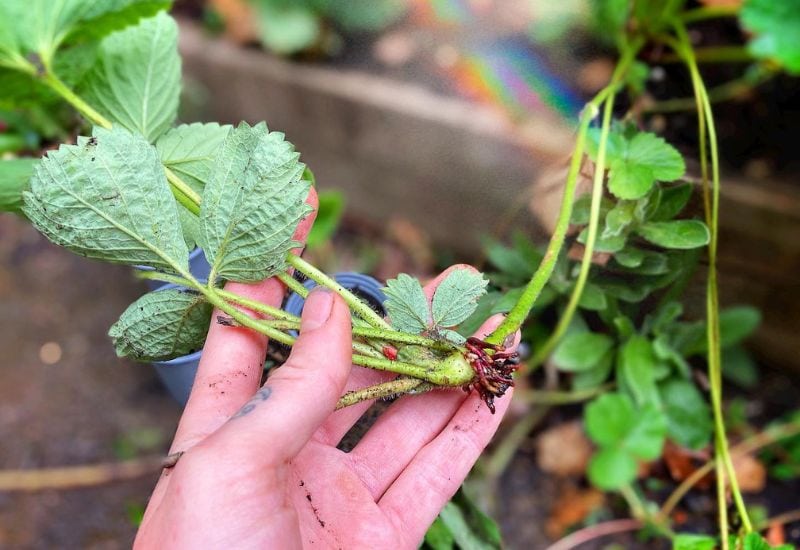
Your everbearing strawberry patch will continually grow as the parent plants will self-propagate by sending out runners.
Bear in mind that everbearing strawberries do not generally send out as many runners as June-bearing varieties.
Removing flowers, especially during the first year, will encourage more runners to develop.
On the flip side, removing runners from your everbearing strawberries will generally stimulate more flower production and hence more berries.
As the runners develop, you can often position them into the desired spot before the new plant has formed.
If one does form in an inconvenient spot, you can simply cut the runner from the main plant, dig up the young plant, and transplant it into a better spot.
Watering

Everbearing strawberries perform best when they have regular water. Because of their shallow root and high crown, strawberries can dry out very easily in hot weather and many gardeners suggest 2.5 cm (1 inch of water) per week is ideal.
Drip irrigation is the preferred way to water as the moisture is put directly into the soil.
The amount you will have to water will greatly depend on your micro-climate. In a hot dry climate, you might have to water once or twice a week.
In our own strawberry patch, the annual rain fall is usually sufficient. We have not had to water our everbearing strawberries and they have given us berries all summer long.
Weeding
Because of the ambling runners that spread in every direction, everbearing strawberries can be tricky to weed since most conventional methods of weeding will not work.
Because of this, perennial weeds can easily establish themselves amongst your strawberries. Carefully hand weeding around your strawberries is the best way to keep them weed-free.
You will be rewarded for your careful attention by strong, healthy plants that will bear delicious berries all spring, summer, and into the fall.
Mulch (for water and weed)

Mulching your strawberries has a number of advantages. First of all, it retains moisture in the soil and keeps your everbearing strawberries naturally moist. Second, it suppresses weeds around your plants.
Third, the layer of mulch can help protect your strawberries from some soil borne diseases.
Straw is the most ideal material for mulching strawberries. If you are dealing with particularly aggressive weeds or grasses, putting cardboard under the straw will work wonders.
As your strawberries start to “walk” in the spring, you can mulch underneath the runners as they develop.
Alternatively, you can wait until after most of the new plants have established themselves before mulching around all the plants.
It might also be a benefit to add a thick layer of mulch around your strawberries in the late fall as the mulch will also protect the delicate roots from freezing over winter.
In this case, you might want to pull back the straw in the spring so the new runners can take root directly in the soil.
Feeding
Strawberries are generally light feeders, meaning they require only minimal nutrients and food to stay healthy. That being said, they are perennials, and as such, it is important to maintain the health of the soil in your strawberry patch year after year.
Since your strawberries will be growing in the same spot for many years, they will greatly benefit from a top dress of compost each spring or fall.
Everbearing strawberries also thrive with the addition of potash. Adding wood ashes to your bed can really be a benefit.
Companion Planting
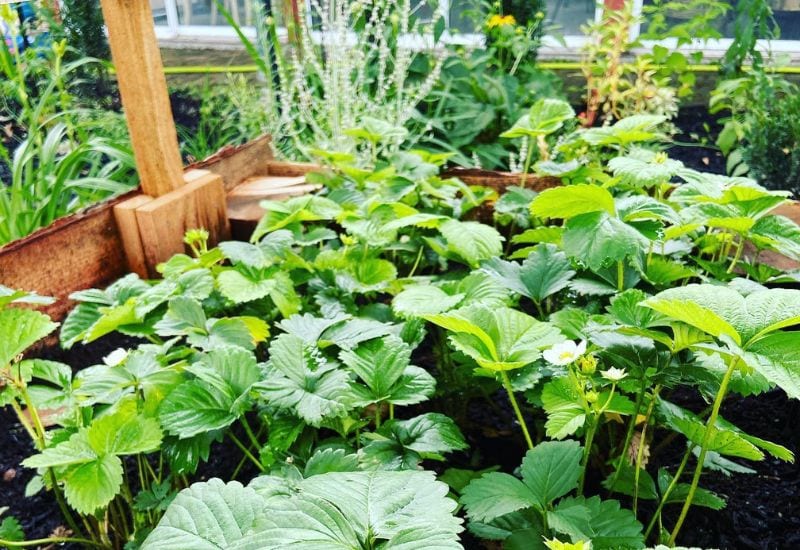
Everbearing strawberries grow well with many other plants such as Alliums (garlic and onions), legumes (beans and peas), and greens. Since they are a perennial, they can also be combined with many herbs such as thyme or chives.
Planting mutually beneficial plants with your strawberries has the advantages of reducing invasive insects by attracting predatory insects, improving fruiting by attracting pollinators, and enriching the soil.
Harvesting
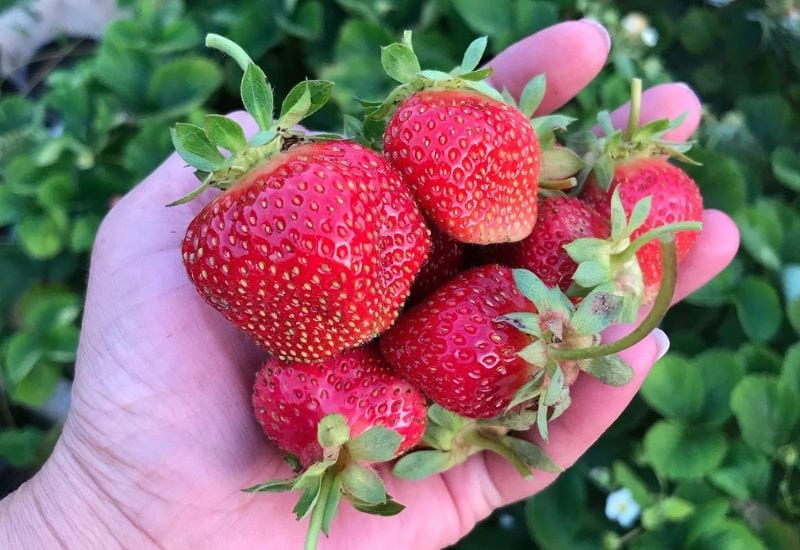
Your everbearing strawberries will generally start setting fruit in midsummer and keep right on producing into the fall. If you garden in a fairly mild area, you might even be lucky enough to harvest berries into November.
Check your plants daily as the berries will ripen quickly. Pick and berries that are ripe and enjoy them fresh or cook them in your favorite recipe.
Most everbearing strawberries will produce for several years, at which point their production might start to decline and many producers will dig up their plants every 3 to 4 years.
That being said, our largest everbearing strawberry has been producing strong for 4 years and doesn’t show signs of slacking.
As a plant’s fruit-bearing declines, dig it under or remove it to the compost bin to make space for the ever-propagating runners that will take its place.
Diseases And Insects
As your strawberries grow, your plot will probably be invaded by undesirables, be they diseases that kill your plants or pests that eat your harvest.
Here are some common issues your strawberries might face and what to do about them.
Diseases
Being a soft fruit, strawberries are very susceptible to several diseases. These issues can attack either the berry or the plant itself.
Powdery Mildew.
This fungus forms white spores on the undersides of the leaves and will often cause the berries to turn brown. Remove any infected leaves or plants that your find. Sulfur can combat powdery mildew, and there are many recipes online that mix baking soda, water, vegetable oil, and dish soap for a natural spray.
Gray Mold (Botrytis).
This is also a common problem with strawberries. It can be identified by gray spots on the leaves and a gray “fur” on the berries. The best prevention for gray mold is to adequately space your plants so they have good air circulation. Remove any diseased plants but do not put them in the compost.
Pests
Unfortunately, we are not the only creatures who think strawberries are delicious. Here are some common critters you will be dealing with amongst your strawberries.
Birds
These are perhaps the most common and devastating problem for strawberries. Putting up a cage or net is the most effective way to keep them at bay. Other deterrents, like hanging scarecrows or shiny objects like pie plates or CDs, can also scare them off.
A word of warning about netting: Most bird netting is actually very dangerous to birds and is not recommended as the birds will get caught in the loose mesh and be injured or killed. Use a net with small openings. As a rule, if you can put your finger through the holes then they are too big.
Four-legged Animals
Rabbits, deer, raccoons, mice, and ground squirrels will all try to raid your berry patch. Again, fencing is the best defense. Determine what animal you are dealing with and fence accordingly.
(Of course, there is no way to fence out a mouse and other small rodents so try and make the surrounding environment unfavorable for these little guys and they will hopefully not come in the first place).
Aphids
Aphids are a problem for strawberry plants because they spread diseases and suck valuable nutrients from the plants’ leaves. Companion planting and floating row covers work best to stop aphids.
Strawberry Beetles
These little nuisances feast on the strawberries themselves. Keeping the bed weeded will often keep them from setting up shop.
Conclusion
I love adding perennials to our garden, and everbearing strawberries give a delightful snack while weeding all summer long. They also produce a steady supply of fresh strawberries for salads, backing, and eating.
Everbearing strawberries are also a great plant to grow for children and they will love checking for the succulent surprises every day.
Give everbearing strawberries a try today, and see them flourish in your garden.

Written By
Amber Noyes
Amber Noyes was born and raised in a suburban California town, San Mateo. She holds a master’s degree in horticulture from the University of California as well as a BS in Biology from the University of San Francisco. With experience working on an organic farm, water conservation research, farmers’ markets, and plant nursery, she understands what makes plants thrive and how we can better understand the connection between microclimate and plant health. When she’s not on the land, Amber loves informing people of new ideas/things related to gardening, especially organic gardening, houseplants, and growing plants in a small space.

